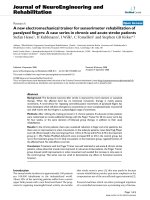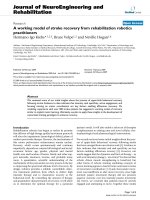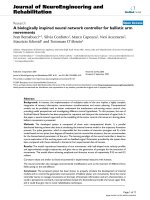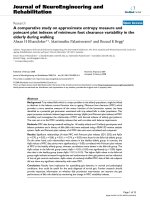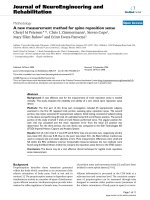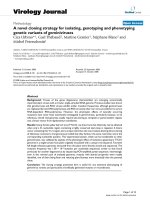báo cáo hóa học: " A new nonlinear impulsive delay differential inequality and its applications" ppt
Bạn đang xem bản rút gọn của tài liệu. Xem và tải ngay bản đầy đủ của tài liệu tại đây (259.86 KB, 8 trang )
RESEA R C H Open Access
A new nonlinear impulsive delay differential
inequality and its applications
Huali Wang and Changming Ding
*
* Correspondence:
zj.cn
School of Mathematical Sciences,
Xiamen University, Xiamen, 361005,
PR China
Abstract
In this article, a new nonlinear impulsive delay differential inequality is established,
which can be applied in the dynamical analysis of nonlinear systems to improve
many extant results. Using the inequality, we obtain some sufficient conditions to
guarantee the exponential stability of nonlinear impulsive functional differential
equations. Two examples are given to illustrate the effectiveness and advantage s of
our results.
Keywords: Impulsive delay differential inequality, exponential stability, nonlinear
functional differential systems
1. Introduction
It is well known that the theory of differential inequalities plays an important role in
the qualitative and quantitative studies of differential equations [1-3]. In recent years,
various inequalities have been established such as the Halanay inequalities in [4-6], the
delay inequalities in [7-10], and the impulsive differential inequalities in [ 11-13]. Using
the linear inequality techniques, many results have been done on the stability and
dynamical behavior for differential systems, see [4-13] and th e references cited therein.
For example, [11] presents an extended impulsive delay Halanay inequality and deals
with the global exponential stability of impulsive Hopfield neural networks with time
delays. In [13], the authors establish a delay differential inequality with impulsive initial
conditions and derive some s ufficient conditions ensuring the exponential stability of
solutions for the impulsive differential equations. However, linear differential inequal-
ities do not work in the studies for nonlinear differential equations. With the develop-
ment of the theory on nonlinear differential equations (e.g., see [14,15]), it is necessary
to study the corresponding nonlinear differential inequalities. In [16], the authors
develop a new nonlinear delay differential inequality that works well in studying a class
of nonlin ear delay differential systems. Indeed, nonlinear delay differential inequalities
with impulses are seldom discussed in the literature. Therefore, in further researc hes
of nonlinear systems, it is beneficial to obtain some new nonlinear impulsive delay dif-
ferential inequalities. Our goal in this article is to do some investigations on such
problems.
Indeed, impulsive effects and delay effects w idely exist in the real world. Impulsive
delay differential equations provide mat hematical models for many phenomena and
processes in the field of natural science and technology. In the last few decades, the
Wang and Ding Journal of Inequalities and Applications 2011, 2011:11
/>© 2011 Wang and Ding; licensee Springer. This is an Open Access article distributed under the terms of the Creative Commons
Attribution Lice nse ( which permits unrestricted use, distribution, and reproduction in
any medium, provided the original work is properly cite d.
stability theory of impulsive functional differential equations has obtained a rapid
development, and many interesting results have b een reported, see [1-8,16-23].
Recently, exponential stability has attracted increasing interest in both theoretical
research and applications [20-22,24]. However, the existing works mainly focus on lin-
ear impulsive functional differential equations [17-19,25]. There exist very little works
devoted to the investigations of exponential stabilities for nonlinear impulsive func-
tional differential systems.
Motivated by the above discussions, in this article, we shall establish a new nonlinear
impulsive delay differential inequality, which improves some recent works in the litera-
ture [9-12,16,18] and can be applied to the dynamical analysis of nonlinear systems.
Based on the inequality, some sufficient conditions guaranteeing the local exponenti al
stability of n onlinear impulsive functional differential equations are derived. Finally,
two examples are given to show the effectiveness and advantages of our proposed
results.
2. Preliminaries
Let ℝ denote the set of real numbers, ℝ
+
the set of nonnegative real numbers, ℤ
+
the
set of positive integers, and ℝ
n
the n-dimensional real space equipped with the Eucli-
dean norm | · |. Consider the following impulsive functional differential systems
⎧
⎨
⎩
x
(t )=f (t, x
t
), t = t
k
,
x(t
k
)=x(t
−
k
)+I
k
(t
k
, x
t
−
k
), k ∈ Z
+
,
x
t
0
= ϕ(s), t
0
− τ<s < t
0
,
(2:1)
where x Î ℝ
n
, the impulse times {t
k
} satisfy 0 ≤ t
0
<t
1
< <t
k
< and lim
k®+∞
t
k
=
+∞,andx’ denotes the right-hand derivative of x. Also, assume f Î C([t
k-1
, t
k
)×Ψ,
ℝ
n
), meanwhile Î Ψ, Ψ is an open set in PC([-τ,0],ℝ
n
), where PC([-τ,0],ℝ
n
)={ψ:
[-τ,0]® ℝ
n
|ψ is continuous except at a finite number of points t
k
, at which
ψ(t
+
k
)
and
ψ(t
−
k
)
exist and
ψ(t
+
k
)=ψ(t
k
)
}. For ψ Î Ψ ,thenormofψ is defined by ||ψ|| = sup
-
τ≤θ≤0
|ψ(θ)|. For each t ≥ t
0
, x
t
Î Ψ i s defined by x
t
(s)=x(t + s), s Î [-τ, 0]. For each k
Î ℤ
+
, I
k
(t,x) Î C(t
0
, ∞)×ℝ
n
, ℝ
n
).
In this article, we suppose that there exists a unique solution of system (2.1) through
each (t
0
, ), s ee [23] for the details. Furthermore, we assume that f(t,0)=0,andI
k
(t,
0) = 0, k Î ℤ
+
,sothatx(t) = 0 is a solution of system (2.1), which is called the trivial
solution.
We now introduce some definitions that will be used in the sequel.
Definition 2.1. ([5]) A function V:[-τ, ∞)×Ψ ® ℝ
+
belongs to class v
0
if
(i) V is continuous on each set [ t
k -1
, t
k
)×Ψ and
lim
(t,ψ)→(t
−
k
,φ)
V(t, ψ)=V(t
−
k
, φ
)
exists,
(ii) V (t, x) is locally Lipschitzian in x and V (t,0)≡ 0.
Definition 2.2. ([5]) Let V Î v
0
, for any (t, ψ) Î [t
k -1
, t
k
)×Ψ, the upper right-hand
Dini derivative of V (t, x) along a solution of system (2.1) is defined by
D
+
V(t, ψ(0)) = lim sup
h
→
0
+
1
h
{V(t + h, ψ(0) + hf (t , ψ)) − V(t, ψ(0))}
.
Wang and Ding Journal of Inequalities and Applications 2011, 2011:11
/>Page 2 of 8
Definition 2.3. ([6]) The trivial solution of system (2.1) is said to b e exponentially
stable, if for any initial data
x
t
0
=
ϕ
,thereexistsal >0,andforeveryε >0,there
exists δ = δ(ε) > 0 such that
|
|x
(
t, t
0
, ϕ
)
|| <εe
−λ(t−t
0
)
, t ≥ t
0
,
whenever || || <δ and t
0
Î ℝ
+
.
Definition 2.4. ([5]) Let x(t)=x(t, t
0
, ) be a solution of system (2.1) through (t
0
, ).
Then the trivial solutio n of (2.1) is said to be globally exponentially stable if for any t
0
> 0, there exist constants l > 0 and M ≥ 1 such that
|
|x
(
t, t
0
, ϕ
)
|| ≤ M||ϕ||e
−λ(t−t
0
)
, t ≥ t
0
.
3. Main results
First, we present a nonlinear impulsive delay differential inequality.
Lemm a 3.1. Assume that there exist constants p >0,q >0,θ >1,and function m(t)
Î PC([t
0
- τ, ∞), ℝ
+
) satisfying the scalar impulsive differential inequality
D
+
m(t ) ≤−pm(t)+q
˜
m
θ
(t ), t ∈ [t
k−1
, t
k
)
,
m(t
k
) ≤ a
k
m(t
−
k
)+b
k
m(t
−
k
− τ), k ∈ Z
+
,
where a
k
, b
k
Î ℝ
+
,
˜
m(t )= sup
t−τ
≤
s
≤
t
m(s
)
. Moreover, there exists a co nstant M ≥ 1 such
that
∞
k
=1
max{1, a
k
+ b
k
e
λτ
}≤
M
. Then
˜
m(t
0
) <
1
M
(
p
q
)
1
θ −1
implies
m(t ) ≤ (
p
q
)
1
θ − 1
e
−λ(t−t
0
)
, t ≥ t
0
,
(3:1)
where l satisfies
0 <λ<p − q[M
˜
m
(
t
0
)
]
θ −1
e
θλτ
.
(3:2)
Proof.Wefirstnotethat
˜
m(t
0
) <
1
M
(
p
q
)
1
θ −1
implies that there exists a scalar l >0
such that the inequality (3.2) holds.
Now, we shall show
m(t ) ≤
˜
m(t
0
)
k−1
m=0
max{1, a
m
+ b
m
e
λτ
}
e
−λ(t−t
0
)
, t ∈ [t
k−1
, t
k
), k ∈ Z
+
,
where a
0
=1,b
0
=0.
In order to do this, let
L(t )=
m(t ) e
λ(t−t
0
)
, t ≥ t
0
,
m(t ), t
0
− τ ≤ t ≤ t
0
.
Now we only need to show that
L(t ) ≤
˜
m(t
0
)
k
−1
m=0
max{1, a
m
+ b
m
e
λτ
}
, t ∈ [t
k−1
, t
k
), k ∈ Z
+
.
Wang and Ding Journal of Inequalities and Applications 2011, 2011:11
/>Page 3 of 8
It is clear that
L
(
t
)
= m
(
t
)
≤
˜
m
(
t
0
)
for t Î [t
0
- τ, t
0
] by the definition of
˜
m
(
t
)
.
Take k = 1, we can prove that
L
(
t
)
≤
˜
m
(
t
0
)
for t Î [t
0
, t
1
). Suppose on the contrary,
then there exists some t Î [t
0
, t
1
) such that
L
(
t
)
>
˜
m
(
t
0
)
.
Let
t
∗
=inf{t ∈ [t
0
, t
1
)
, L
(
t
)
>
˜
m
(
t
0
)
}
, then
L
(
t
∗
)
=
˜
m
(
t
0
)
,
L
(
t
)
≤
˜
m
(
t
0
)
, t Î [t
0
- τ , t*],
and D
+
L(t*) ≥ 0. Calculating the upper right-hand Dini derivative of L(t)alongthe
solution of (2.1), it can be deduced that
D
+
L(t )|
t=t
∗
= D
+
m(t
∗
)e
λ
(
t
∗
−t
0
)
+ λm(t
∗
)e
λ
(
t
∗
−t
0
)
≤ [−pm(t
∗
)+q
˜
m
θ
(t
∗
)]e
λ(t
∗
−t
0
)
+ λm(t
∗
)e
λ(t
∗
−t
0
)
=(λ − p)m(t
∗
)e
λ(t
∗
−t
0
)
+ q(sup
t
∗
−τ ≤s≤t
∗
L(s)e
−λ(s−t
0
)
)
θ
e
λ(t
∗
−t
0
)
≤ ( λ − p)L(t
∗
)+qe
λ(t
∗
−t
0
)
˜
m
θ
(t
0
)e
−θλ(t
∗
−τ −t
0
)
≤ ( λ − p)
˜
m(t
0
)+q
˜
m
θ
(t
0
)e
θλτ
e
−λ(θ −1)(t
∗
−t
0
)
≤ ( λ − p)
˜
m(t
0
)+q
˜
m
θ
(t
0
)e
θλτ
≤
(
λ − p + q
˜
m
θ −1
(
t
0
)
e
θλτ
)
˜
m
(
t
0
)
< 0,
which is a contradiction. So we have proven
L
(
t
)
≤
˜
m
(
t
0
)
for all t Î [t
0
, t
1
).
Furthermore, we have
L(t
1
)=m(t
1
)e
λ(t
1
−t
0
)
≤ [a
1
m(t
−
1
)+b
1
m(t
−
1
− τ)]e
λ(t
1
−t
0
)
≤ (a
1
+ b
1
e
λτ
)
˜
m(t
0
)
≤ max{1, a
1
+ b
1
e
λτ
}
˜
m
(
t
0
)
.
Next we sha ll show
L
(
t
)
≤ max{1, a
1
+ b
1
e
λτ
}
˜
m
(
t
0
)
, t ∈ [t
1
, t
2
)
. Suppose on the con-
trary, then there exists some t Î [t
1
, t
2
)suchthat
L
(
t
)
> max{1, a
1
+ b
1
e
λτ
}
˜
m
(
t
0
)
.Let
t
∗∗
=inf{t ∈ [t
1
, t
2
)
, L
(
t
)
> max{1, a
1
+ b
1
e
λ
τ
}
˜
m
(
t
0
)}
,then
L
(
t
∗∗
)
=max{1, a
1
+ b
1
e
λτ
}
˜
m
(
t
0
)
,and
L
(
t
)
≤ max{1, a
1
+ b
1
e
λτ
}
˜
m
(
t
0
)
, t Î [t
0
- τ , t** ],
D
+
L(t**) ≥ 0. Calculating the upper right-hand Dini derivative of L(t) along the solution
of (2.1), it can be deduced that
D
+
L(t )|
t=t
∗∗
= D
+
m(t
∗∗
)e
λ(t
∗∗
−t
0
)
+ λm(t
∗∗
)e
λ(t
∗∗
−t
0
)
≤ [−pm(t
∗∗
)+q
˜
m
θ
(t
∗∗
)]e
λ(t
∗∗
−t
0
)
+ λm(t
∗∗
)e
λ(t
∗∗
−t
0
)
=(λ − p)m(t
∗∗
)e
λ(t
∗∗
−t
0
)
+ q(sup
t
∗∗
−τ ≤s≤t
∗∗
L(s)e
−λ(s−t
0
)
)
θ
e
λ(t
∗∗
−t
0
)
≤ ( λ − p)L(t
∗∗
)+qe
λ(t
∗∗
−t
0
)
L
θ
(t
∗∗
)e
−θλ(t
∗∗
−τ −t
0
)
≤ ( λ − p)L(t
∗∗
)+qL
θ
(t
∗∗
)e
θλτ
e
−λ(θ −1)(t
∗∗
−t
0
)
≤ ( λ − p + qL
θ −1
(t
∗∗
)e
θλτ
)L(t
∗∗
)
≤
(
λ − p + q[max{1, a
1
+ b
1
e
λτ
}
˜
m
(
t
0
)
]
θ −1
e
θλτ
)
L
(
t
∗∗
)
< 0,
which is a contradiction. So we have proven
L
(
t
)
≤ max{1, a
1
+ b
1
e
λ
τ
}
˜
m
(
t
0
)
for all t
Î [t
1
, t
2
).
By the method of induction, we prove that for t Î [t
k -1
, t
k
], k Î ℤ
+
,
L(t ) ≤
˜
m(t
0
)
k−1
m=0
max{1, a
k
+ b
k
e
λτ
}
,
Wang and Ding Journal of Inequalities and Applications 2011, 2011:11
/>Page 4 of 8
i.e.,
m(t ) ≤
˜
m(t
0
)
t
0
≤t
k
<t
max{1, a
k
+ b
k
e
λτ
}
e
−λ(t−t
0
)
≤ M
˜
m(t
0
)e
−λ(t−t
0
)
≤ (
p
q
)
1
θ − 1
e
−λ(t−t
0
)
, t ≥ t
0
.
So (3.1) holds. The proof of Lemma 3.1 is complete.
Remark 3.1. In [9-18], the authors got some results for linear differential inequalities
under the assumption that p >q. Note in our result, the restriction p >q is completely
removed if the initial value satisfies some certain conditions.
Remark 3.2.Itshouldbenotedthatifp >q,then
lim
θ →1
+
1
M
(
p
q
)
1
θ − 1
→ +
∞
,which
implies that (3.1) holds for any initial value
˜
m
(
t
0
)
∈ R
+
.Inthissense,Lemma3.1
becomes the well known case, see [16]. Hence, our development result has wider adap-
tive range than those in [9-12,16,18].
Next, based on Lemma 3.1, we shall construct a suitable Lyapunov function to derive
some condition s guaranteeing the exponential stability of the trivial solution of system
(2.1).
Theorem 3.1. Assume that there exist function V (t, x) Î v
0
, and constants 0<c
1
≤
c
2
, m >0,p >0,q >0,θ >1such that the following conditions hold:
(i) c
1
||x||
m
≤ V (t, x) ≤ c
2
||x||
m
,(t, x) Î (ℝ
+
,ℝ
n
);
(ii) For t ≥ t
0
, t ≠ t
k
,
D
+
V
(
t, ψ
(
0
))
≤−pV
(
t, ψ
(
0
))
+ q
˜
V
θ
(
t, ψ
(
0
)),
where
˜
V
(t , ψ(0)) = sup
−τ
≤
θ
≤
0
V(t + θ , ψ(θ)
)
;
(iii) For any ψ Î PC([ - τ , 0], R
n
),
V
(t
k
, ψ(0) + I
k
(t
k
, ψ)) ≤ a
k
V(t
−
k
, ψ(0)) + b
k
V(t
−
k
− τ , ψ(0)), k ∈ Z
+
,
where
a
k
, b
k
∈ R
+
,
∞
k
=1
max{1, a
k
+ b
k
e
λτ
} < +
∞
.
Then the trivial solution of system (2.1) is exponentially stable.
Proof. Let x(t)=x(t, t
0
, ) be any solution of system (2.1) with initial value (t
0
, ). By
condition (iii), we know that there exists M ≥ 1 such that
∞
k
=1
max{1, a
k
+ b
k
e
λτ
}≤
M
.
For any given
ε ∈ (0, [
1
c
2
M
(
p
q
)
1
θ − 1
]
1
m
)
, cho ose some δ >0suchthat
δ ≤ min(ε, ε(
c
1
c
2
M
)
1
m
)
.When|||| <δ <ε,wehave
˜
V
(t
0
) ≤ c
2
||ϕ||
m
<
1
M
(
p
q
)
1
θ − 1
.
Using Lemma 3.1 and the condition (i), we derive
c
1
||x||
m
≤ V
(
t, x
)
≤ M
˜
V
(
t
0
)
e
−λ(t−t
0
)
≤ Mc
2
||ϕ||
m
e
−λ(t−t
0
)
, t ≥ t
0
,
Wang and Ding Journal of Inequalities and Applications 2011, 2011:11
/>Page 5 of 8
i.e.,
|
|x|| ≤
Mc
2
c
1
1
m
||ϕ||e
−
λ
m
(t−t
0
)
<εe
−
λ
m
(t−t
0
)
, t ≥ t
0
.
By the definition 2.3, the trivial so lution of system (2:1) is exponentially stable. This
completes the proof.
Remark 3.3. From the proof of the Theorem 3.1, it follows that if p >q, θ ® 1
+
,the
trivial solution of system (2.1) is globally exponentially stable.
4. Examples
In this section, we shall give two examples to illustrate the effectiveness of our results.
Example 1. Consider the impulsive functional differential equation as follows:
⎧
⎪
⎪
⎨
⎪
⎪
⎩
x
(t )=−a(t)x(t)+b(t) x
θ
(t − τ (t)), t ≥ 0, t = t
k
,
x(t
k
)=
k
2
k
2
+1
x(t
−
k
), k ∈ Z
+
,
x
t
0
= ϕ(s), t
0
− τ ≤ s ≤ t
0
,
(4:1)
where θ >1,a(t) ≥ a >0,0<|b(t)| ≤ b, 0 ≤ τ (t) ≤ τ, for all t ≥ t
0
.
Property 4.1. The trivial solution of system (4.1) is exponentially stable.
Proof. Choose V (t)=|x(t)|. When t ≠ t
k
, calculating the derivative of D
+
V (t)along
the solution of (4.1), we get
D
+
V(t)=x
(t )sgnx(t)
= −a(t)x(t)sgnx(t )+b(t)sgnx(t)x
θ
(t − τ (t))
,
≤−a|x(t)| + bx
θ
(t − τ (t)),
≤−aV
(
t
)
+ b
˜
V
θ
(
t
)
,
where
˜
V
(t )= sup
t−τ
≤
s
≤
t
V(s
)
. Furthermore,
V
(t
k
)=|x(t
k
)| =
k
2
k
2
+1
|x(t
−
k
)| =
k
2
k
2
+1
V(t
−
k
)
.
Hence, by Theorem 3.1, the trivial solution of system (4.1) is exponentially stable.
Example 2. Consider the following impulsive functional differential equation with
distributed delays:
⎧
⎪
⎪
⎪
⎪
⎨
⎪
⎪
⎪
⎪
⎩
x
(t )=−ax(t)+b
t
t−τ
x
θ
(s)ds, t ≥ 0, t = t
k
,
x(t
k
)=
k
k +1
x(t
−
k
), k ∈ Z
+
,
x
t
0
= ϕ(s), t
0
− τ ≤ s ≤ t
0
,
(4:2)
where θ >1,a >0,b Î ℝ.
Property 4.2. The trivial solution of system (4.2) is exponentially stable.
Proof. Choose V (t)=|x(t)|. When t ≠ t
k
, calculating the derivative of D
+
V (t)along
the solution of (4:2), we get
Wang and Ding Journal of Inequalities and Applications 2011, 2011:11
/>Page 6 of 8
D
+
V(t)=x
(t )sgnx(t) ≤−ax(t)sgnx(t)+bτ sgnx(t)sup
t−τ ≤s≤t
x
θ
(s)
,
≤−a|x(t)| + |b|τ sup
t−τ ≤s≤t
|x(s)|
θ
,
≤−aV
(
t
)
+ |b|τ
˜
V
θ
(
t
)
,
where
˜
V
(t )= sup
t−τ
≤
s
≤
t
V(s
)
. Furthermore, we have
V(t
k
)=|x(t
k
)| =
k
k
+1
|x(t
−
k
)| =
k
k
+1
V(t
−
k
)
.
Hence, by Theorm 3.1, the trivial solution of system (4.2) is exponentially stable.
Remark 3.4 It should be noted that the sufficient conditions ensuring the exponential
stabilities of (4.1) and (4.2) are e asily to check, which show the advantages of our
results.
Acknowledgements
The authors sincerely thanks the referees for their valuable suggestions.
Authors’ contributions
HW designed and performed all the steps of proof in this research and also wrote the paper. CD participated in the
design of the study and suggest many good ideas that made this paper possible and helped to draft the first
manuscript. All authors read and approved the final manuscript.
Competing interests
The authors declare that they have no competing interests.
Received: 19 February 2011 Accepted: 20 June 2011 Published: 20 June 2011
References
1. Lakshmikantham, V, Bainov, DD, Simeonov, PS: Theory of Impulsive Differential Equations. World Scientific, Singapore
(1989)
2. Lakshmikantham, V, Leela, S: Differential and Integral Inequalities. Academic Press, New York (1969)
3. Bainov, DD, Simenov, PS: Systems with Impulse Effect: Stability Theory and Applications. Ellis Horwood Limited,
Chichester (1989)
4. Halanay, A: Differential Equations, Stability, Oscillation, Time Lags. Academic Press, New York (1996)
5. Baker, CTH, Tang, A: Generalized Halanay inequalities for Volterra functional differential equations and discretised
versions. In: Corduneanu, C, Sandberg, IW (eds.) Volterra Equations and Applications. Gordon and Breach, Amsterdam
(1999)
6. Gopalsamy, K: Stability and Oscillations in Delay Differential Equations of Population Dynamics. Kluwer Academic,
Dordrecht (1992)
7. Tian, H: The exponential asymptotic stability of singularly perturbed delay differential equations with a bounded lag. J
Math Anal Appl. 270(1), 143–149 (2002). doi:10.1016/S0022-247X(02)00056-2
8. Jiang, M, Shen, Y, Liao, X: On the global exponential stability for functional differential equations. Commun Nonlinear
Sci Numer Simul. 10(7), 705–713 (2005). doi:10.1016/j.cnsns.2004.05.002
9. Nieto, J: Differential inequalities for functional perturbations of first-order ordinary differential equations. Appl Math Lett.
15(2), 173–179 (2002). doi:10.1016/S0893-9659(01)00114-8
10. Ladas, G, Stavroulakis, P: On delay differential inequalities of first order. Funkcialaj Ekvacioj. 25(1), 105–113 (1982)
11. Fu, X, Li, X: Global exponential stability and global attractivity of impulsive Hopfield nenural networks with time delays.
J Comput Appl Math. 231(1), 187–199 (2009). doi:10.1016/j.cam.2009.02.094
12. Li, X: Existence and global exponential stability of periodic solution for impulsive Cohen-Grossberg-type BAM neural
networks with continuously distributed delays. Appl Math Comput. 215(1), 292–307 (2009). doi:10.1016/j.
amc.2009.05.005
13. Xu, D, Yang, Z: Impulsive delay differential inequality and stability of neural networks. J Math Anal Appl. 305(1),
107–120 (2005). doi:10.1016/j.jmaa.2004.10.040
14. El-Gebeily, MA, O’Regan, D: Existence and boundary behavior for singular nonlinear differential equations with arbitrary
boundary conditions. J Math Anal Appl. 334(1), 140–156 (2007). doi:10.1016/j.jmaa.2006.12.040
15. O’Regan, D, El-Gebeily, MA: Existence, upper and lower solutions and quasilinearization for singular differential
equations. IMA J Appl Math. 73(1), 323–344 (2008)
16. Xu, D, Xu, L: New results for studying a certain class nonlinear delay differential systems. IEEE Trans Autom Control.
55(7), 1641–1645 (2010)
17. Fu, X, Li, X: Razumikhin-type theorems on exponential stability of impulsive infinite delay differential systems. J Comput
Appl Math. 224(1), 1–10 (2009). doi:10.1016/j.cam.2008.03.042
18. Wang, Q, Liu, X: Exponential stability for impulsive delay differential equations by Razumikhin method. J Math Anal
Appl. 309(2), 462–473 (2005). doi:10.1016/j.jmaa.2004.09.016
Wang and Ding Journal of Inequalities and Applications 2011, 2011:11
/>Page 7 of 8
19. Wang, Q, Liu, X: Impulsive stabilization of delay differential systems via the Lyapunov-Razumikhin method. Appl Math
Lett. 20(8), 839–845 (2007). doi:10.1016/j.aml.2006.08.016
20. Anokhin, A, Berezansky, L, Braverman, E: Exponential stability of linear delay impulsive differential equations. J Math Anal
Appl. 193(3), 923–941 (1995). doi:10.1006/jmaa.1995.1275
21. Berezansky, L, Idels, L: Exponential stability of some scalar impulsive delay differential equation. Commun Appl Math
Anal. 2(1), 301–309 (1998)
22. Li, X: New results on global exponential stabilization of impulsive functional differential equations with infinite delays or
finite delays. Nonlinear Anal Real World Appl. 11(5), 4194–4201 (2010). doi:10.1016/j.nonrwa.2010.05.006
23. Ballinger, G, Liu, X: Existence and uniqueness results for impulsive delay differential equations. Dyn Continuous Discr
Impulsive Syst. 5(1), 579–591 (1999)
24. Li, X: Uniform asymptotic stability and global stability of impulsive infinite delay differential equations. Nonlinear Anal
Theory Methods Appl. 70(5), 1975–1983 (2009). doi:10.1016/j.na.2008.02.096
25. Stamova, IM, Stamov, GT: Lyapunov-Razumikhin method for impulsive functional differential equations and applications
to the population dynamics. J Comput Appl Math. 130(1-2), 163–171 (2001). doi:10.1016/S0377-0427(99)00385-4
doi:10.1186/1029-242X-2011-11
Cite this article as: Wang and Ding: A new nonlinear impulsive delay differential inequality and its applications.
Journal of Inequalities and Applications 2011 2011:11.
Submit your manuscript to a
journal and benefi t from:
7 Convenient online submission
7 Rigorous peer review
7 Immediate publication on acceptance
7 Open access: articles freely available online
7 High visibility within the fi eld
7 Retaining the copyright to your article
Submit your next manuscript at 7 springeropen.com
Wang and Ding Journal of Inequalities and Applications 2011, 2011:11
/>Page 8 of 8
